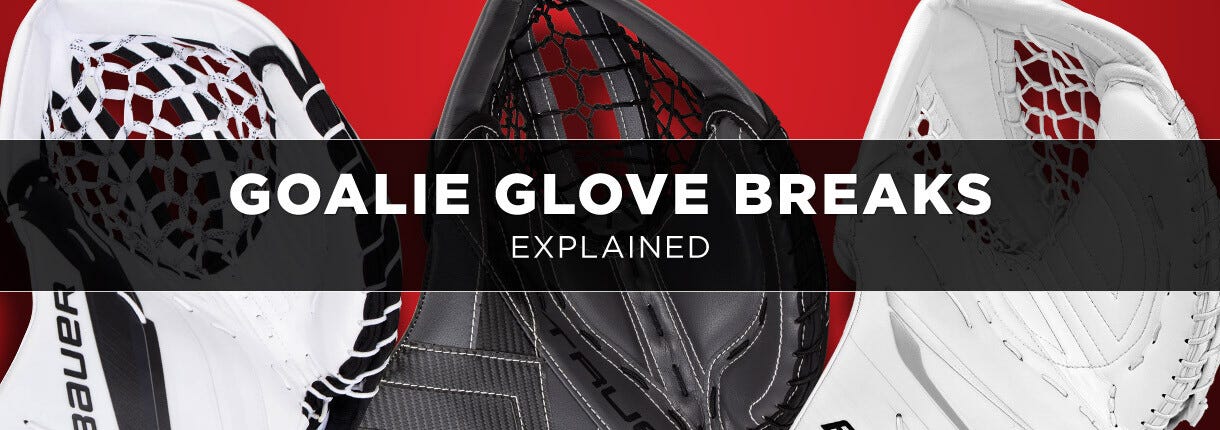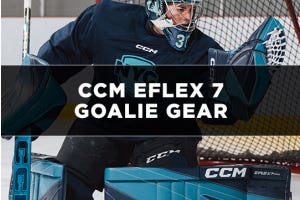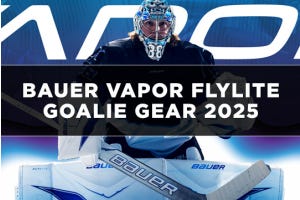Goalie Glove Break Angles: What Every Goalie Needs to Know

Discover how break angles in goalie gloves affect your performance on the ice. Learn the differences to find the perfect fit for your style of play.
In this article, we will discuss
Goalie Glove Break Angles: Which One is Right for You?
In the fast-paced world of goaltending, every piece of equipment matters, and the goalie glove is no exception. Among the array of options available, the 580, 590, and 600 glove breaks stand out as popular choices, each offering unique benefits tailored to goaltenders' preferences and playing styles. Choosing the right goalie glove break angle is crucial to your performance on the ice, as it directly impacts how the glove closes, the grip it offers, and the shape of the pocket for catching pucks. A glove’s break angle refers to the specific spot where the glove folds, which affects how it feels in your hand and how easily you can close it during play. The three most common break angles—580, 590, and 600—each offer distinct advantages depending on your preferences and playing style.
Let's delve into the nuances of these glove breaks to understand their differences and how they impact a goalie's performance on the ice.
What is a Goalie Glove Break Angle?
The break angle of a goalie glove refers to the angle at which the glove naturally closes, influencing how it feels in the hand and how it handles the puck. This angle affects the shape of the pocket and how the goalie positions their hand to close the glove. A 580 break (90 degrees) offers a steeper closure, similar to a thumbs-up position, pulling the fingers into the palm. This is mostly seen in custom options, but now we do carry the Bauer V90 as a stock 580 option. The 590 break (60 degrees) closes toward the base of the thumb and is the most popular, used in CCM, True, Vaughn, and Bauer gloves. The 600 break (75 degrees) closes from the fingertips to the thumb, creating a wider, deeper pocket, found in gloves like the Bauer Shadow. Each break affects how quickly and comfortably a goalie can close their glove, impacting puck retention and reaction time.
580 Glove Break
- Designed for catching pucks near the ears without needing to turn the glove inward.
- Offers a 90-degree closure, pulling the pocket into the palm for easier puck playing.
- Facilitates a straight-up hand position, eliminating the need to tilt the glove in any direction.
- Notable for its unique twist in closure angle, making it ideal for goalies who prioritize puck control and quick releases.
- Popularized by NHL goaltenders like Stuart Skinner of the Edmonton Oilers.
- Provides a natural orientation for catching pucks, enhancing overall agility and responsiveness.
- Specialized Use: The 580 break is particularly effective for goalies who prefer a forward hand position and play an aggressive catching style. It’s popular among goalies who are skilled at playing the puck and making high glove saves, abilities that come with advanced practice and situational awareness.
Glove 590 Break
- Brings the index finger closer to the base of the thumb, creating a more natural closure.
- Offers a comfortable, easy-to-close feel, suitable for a wide range of hand sizes and strengths.
- Known for its versatility, accommodating different playing styles and preferences.
- This glove features a 60-degree closure.
- Provides a clean break line, with the pocket closing more towards the palm than the 600 break.
- Favored by goaltenders who prioritize a traditional feel and consistent performance.
- Offers a balance between mobility and control, making it a reliable choice for goalies at all levels.
- This configuration allows for quick, efficient hand movements, making it ideal for reacting to fast shots while still providing secure puck retention. Its versatility makes the 590 break a popular choice among goalies who prioritize both performance and comfort in their glove.
Glove 600 Break
- Inspired by baseball first baseman's mitts, with a full-hand closure pulling fingers towards the thumb.
- Provides a basket-like catch, ideal for goaltenders who prefer a glove that sits upright and forward.
- Positions the pocket further out and away from the hand, reducing the risk of missed pucks towards the outer edge of the glove.
- Offers a flat break line, with the pocket extending outwards for maximum coverage.
- This glove features a 75-degree closure.
- Popularized by elite goaltenders like Carey Price, known for its stability and reliability.
- Suitable for goaltenders looking for a glove that offers maximum coverage and control, especially when facing high-speed shots.
- Technical Handling: The 600 break is often favored by goalies who have refined their glove hand technique and can consistently position the glove correctly to take advantage of its unique closure pattern. For beginners, mastering this positioning can be more difficult and may require more practice.
Goalie Glove Break for Beginners
| Break Type | 580 Break | 590 Break | 600 Break |
| Features | Steeper break, closes with fingers pulling into palm. | Mid-level break, closes from index finger to thumb base | Flatter break, closes at the base of hand |
| Recommended | Goalies preferring a finger-close feel | Goalies seeking versatility | Goalies preferring more catching surface |
Benefits/Purpose | Great closure with the ability to reach puck in tight areas around the face. Enhances puck retention and offers more control with finger closure. | Offers a mix of flexibility and catching area, providing solid grip and closure control. Good for goalies who want balance between comfort and reach. | Larger pocket that helps trap pucks more securely, ideal for goalies who want a wide, deep pocket and reliable closure with minimal effort. |
For beginners, the 590 glove break is often recommended as the best option. Here's why:
Versatility: The 590 break offers a versatile feel that can accommodate a wide range of playing styles and preferences. Whether you're just starting out or refining your skills, the 590 break provides a comfortable and natural closure, making it easier to adapt to different techniques.
Ease of Use: Beginners often find the 590 break easier to use due to its natural feel and straightforward closure angle. This break brings the index finger closer to the base of the thumb, creating a more intuitive catching motion that requires minimal adjustment.
Consistency: The 590 break is known for its consistency, providing goalies with reliable performance game after game. As a beginner, having equipment that you can trust is essential for building confidence and improving your skills over time.
Accessibility: Since the 590 break is a popular choice among goaltenders of all levels, it's widely available from various brands and retailers. This means beginners can easily find 590 break gloves in stock and ready to purchase, without having to search extensively or wait for special orders.
Goalie Glove Break Angles FAQs
Are there specific break angles designed for different hand sizes or glove preferences?
Yes, break angles can be influenced by hand size and glove preference. Smaller hands might feel more comfortable with a steeper break (like a 580), which offers a more natural and controlled closure. Larger hands or goalies preferring more pocket space might opt for a flatter break (like a 600) that provides a wider catching surface. Ultimately, personal comfort and how the glove closes are the key factors.
Can the break angle impact a goalie’s ability to catch or block pucks?
Absolutely. The break angle affects how easily and quickly the glove closes, which can influence a goalie’s ability to catch pucks cleanly. A steeper angle (580) provides a tighter grip for quicker hand closure, while a flatter break (600) creates a larger pocket for better puck trapping. The right break can improve performance, while the wrong one might cause pucks to slip or affect a goalie’s reaction time.
What break angle is most commonly used by professional goalies?
The 590 break is the most commonly used among professional goalies. It offers a versatile balance between grip and pocket depth, allowing for a strong middle-palm closure that works well in various playing styles. However, many goalies experiment with different angles based on personal preference and performance needs.
How do I know if I need a glove with a steeper or flatter break angle?
The best way to determine your ideal break angle is by trying different gloves on the ice. If you prefer a glove that feels like a baseball mitt and closes naturally toward the fingers, a steeper break (580) is ideal. If you prefer a deeper pocket that easily traps pucks, then a flatter break (600) is a better fit. The 590 break offers a middle ground for goalies looking for versatility.
Can I adjust or customize the break angle of my goalie glove after purchase?
The break angle is fixed during the glove’s manufacturing process, so it cannot be adjusted after purchase. However, goalies can customize other aspects, such as the pocket shape or stiffness, by breaking in the glove differently. Custom glove orders may allow some choice in break angles before manufacturing, but once a glove is built, the break angle is permanent.











